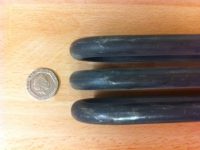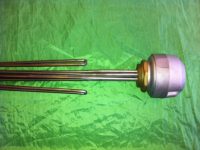In terms of brewing, the higher the watt density, the higher the temperature of the sheath and consequently the more your wort, hops, etc are going to stick to that element. This starts an unfortunate snowball rolling downhill. As “stuff” sticks, the heat being produced by the element cannot dissipate (or get away) so the element sheath gets even hotter, and more “stuff” sticks. This explains the importance of cleaning any crust off your elements as, once its there, it’s only going to get worse, until it kills the element. Unless you get it off.
Which may explain why one brewer told me today that he’d been advised to spend 45 minutes cleaning EACH ELEMENT of his heaters. WOW, 2 hours & 15 minutes to clean one immersion heater. Every brew. We need to bring back child slavery or expand the Apprenticeship system for this investment of time and labour to be viable!?!
I’m all for advising you to look after your stuff, so you don’t have to speak to me too often, but 135 minutes?
Having spoken to many a brewer over the last few years (it seems to be the only expanding area of production industry, due to that little quirk of the tax & vat laws, long may it continue), it seems that everybody cleans a different way. I’ve heard of toothbrushes, scouring pads, lemon juice & other mild acids, mild alkali products, jet washing, steam cleaning & even the cleaning fairy. Whatever works for you.
So, to sum up, we have to keep the watt density down, while giving you brewers the heating power you crave, to get up to temperature as rapidly as possible. Cleaning time is wasted brewing time, but keeping the elements crud free will extend the working life considerably.
So how do we address these issues? By giving you, the brewing customer the relevant, educational information and a range of alternative solutions, to suit different pockets and different levels of urgency of need (ie, if you’ve boiled dry and blown a heater up and are unable to brew, meaning you want it yesterday, or if you are planing an upscale to greater brewing capacity, and can wait a couple or 3 weeks for delivery of something tailor made).




Whichever option tickles your fancy, or if you just want to ask a question, or perhaps you want to report a sighting of the Cleaning Fairy, call Tim on 07864 931524.